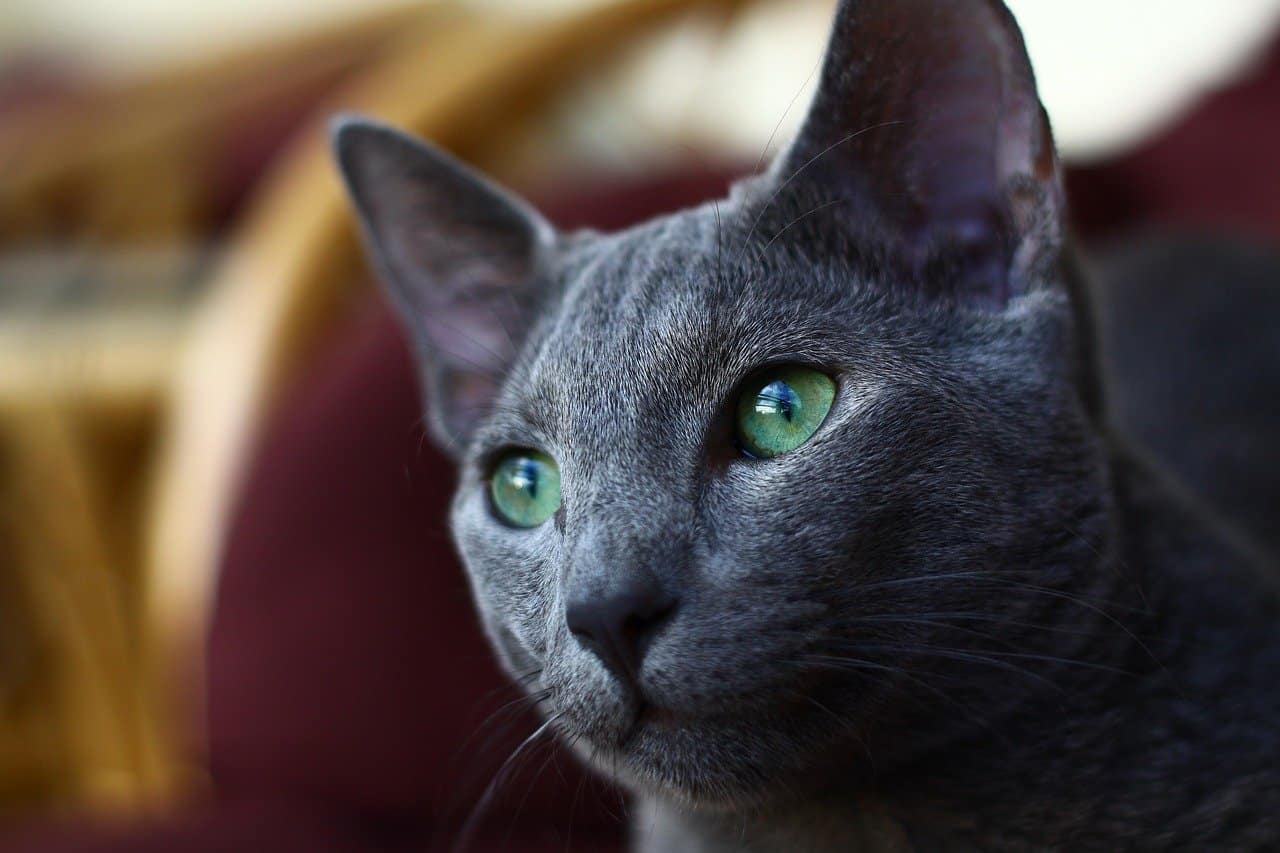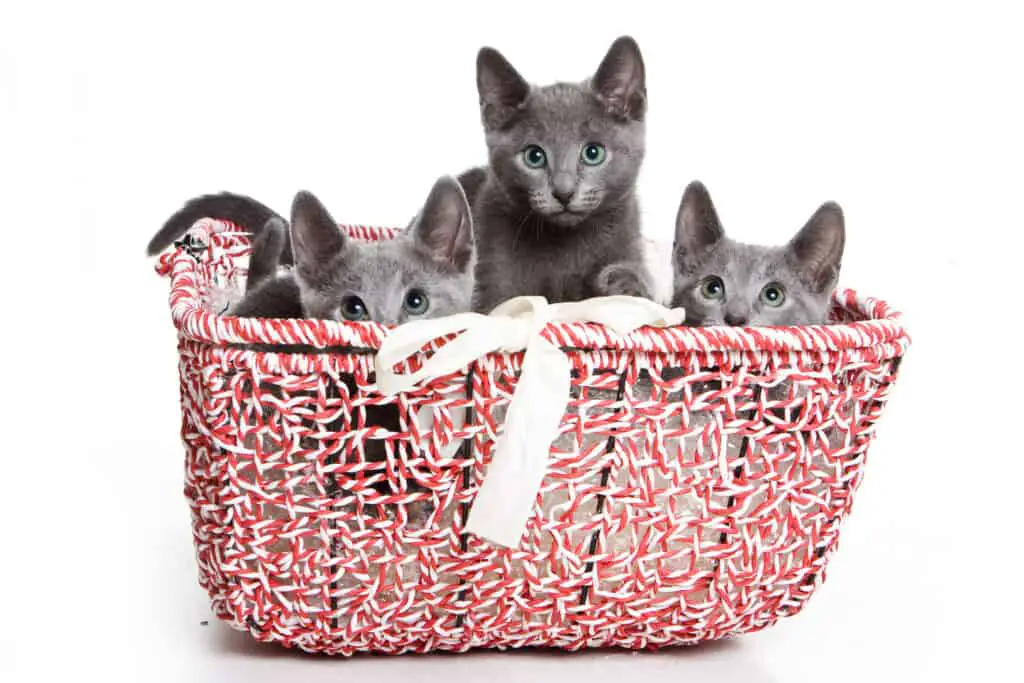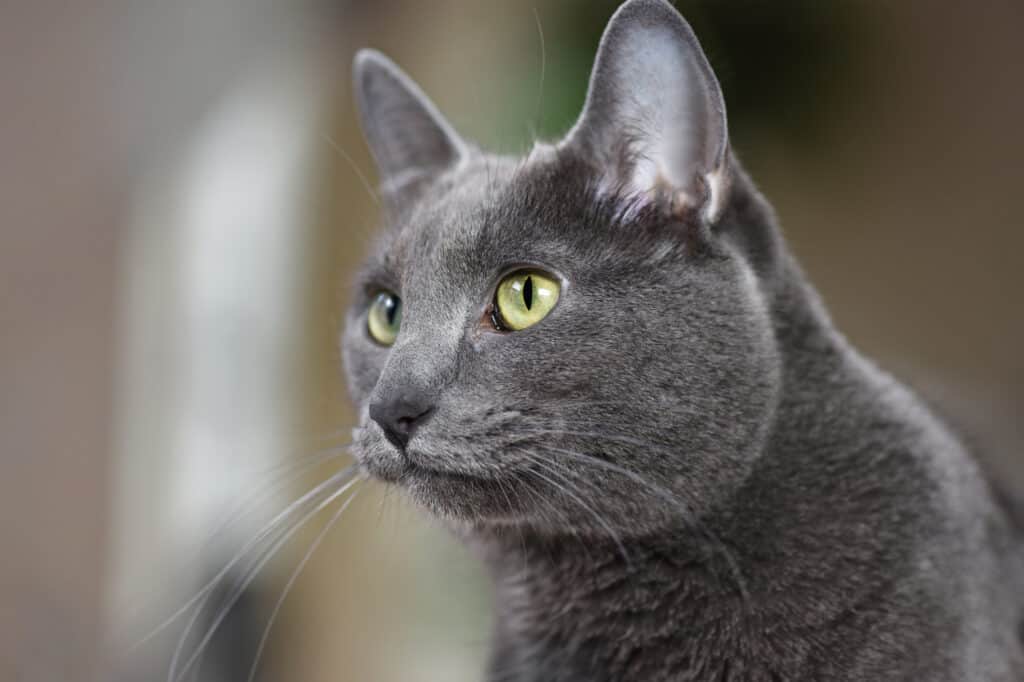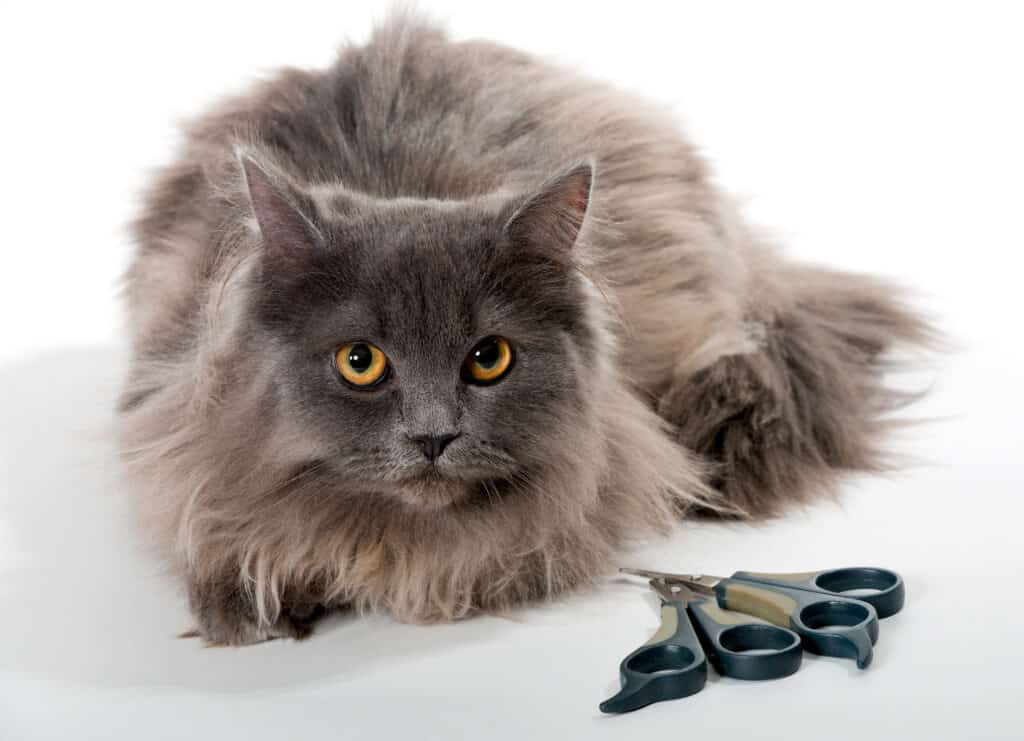With its blueish, gray coat, the Russian Blue cat has an unmistakable beauty and can easily win anyone’s heart with its sweet and calm personality traits.
Many people worldwide are fascinated by Russian Blues and don’t hesitate to look for this feline companion to call their own. So we’ve gathered the most important facts about these gorgeous kitties and created this overview here.
Russian Blue cats originated in Russia around 1860 and are characterized by their beautiful double, silvery coat, intelligence, and easy-going, lovable personality. This breed is great for people who deal with allergies because Russian Blues are hypoallergenic. They are relatively rare but among the more affordable purebreds.
Where did the Russian Blue breed originate?
As the name implies, Russian Blues appeared first in Russia, more specifically in the port city of Arkhangelsk. Hence, this breed is also known as an “archangel cat.” In fact, it is said that their fur was highly valued by the tsars, who admired their beautiful dense coat.
According to one of the existing theories about their origin in the nineteenth century (around 1860), an English merchant ship took several specimens to Great Britain, where they began to exhibit them for their elegant and lustrous, plush coat.
The first public appearance dates from 1875 during the feline exhibition at the Crystal Palace in London. As of 1871, they are presented under the name of “Russian short hair,” “blue archangel,” or “blue foreign.”
In 1939 the breed was officially recognized. However, given the shortage of pure specimens due to World War II, English breeders had to cross them with Scandinavian breeds or with Siamese cats, giving rise to the current Russian Blue. As a result of these crosses, there are two variants: the American and English types.
Also, it is after World War II that the arrival of the Russian Blue cat in America took place, which was when the animal began to become increasingly popular.
What does a Russian Blue look like?
The Russian Blue is a medium-sized cat, slender, with thin legs and elegant movements. Their body is lean and fine-boned, yet they have a firm musculature that gives them an elegant appearance.
A curious and striking feature of the Russian Blue cat is its enigmatic smile. Their head is wedge-shaped, short, and with a flat skull, narrow nose. They have green eyes, often referred to as emerald, which are almond-shaped and wide apart. In kittens, the shade varies from yellow to green. Their ears are large, with slightly rounded tips, projected forward and set far apart.
The Russian Blue has a double coat, which means there are two layers; a shorter undercoat and longer hairs as an overcoat. As a result, their fur is dense and very soft.
Their coat color is what makes them truly unique. It’s a uniform blueish gray with silver highlights at the ends of the strands. These highlights give their already marvelous cat an even brighter appearance.
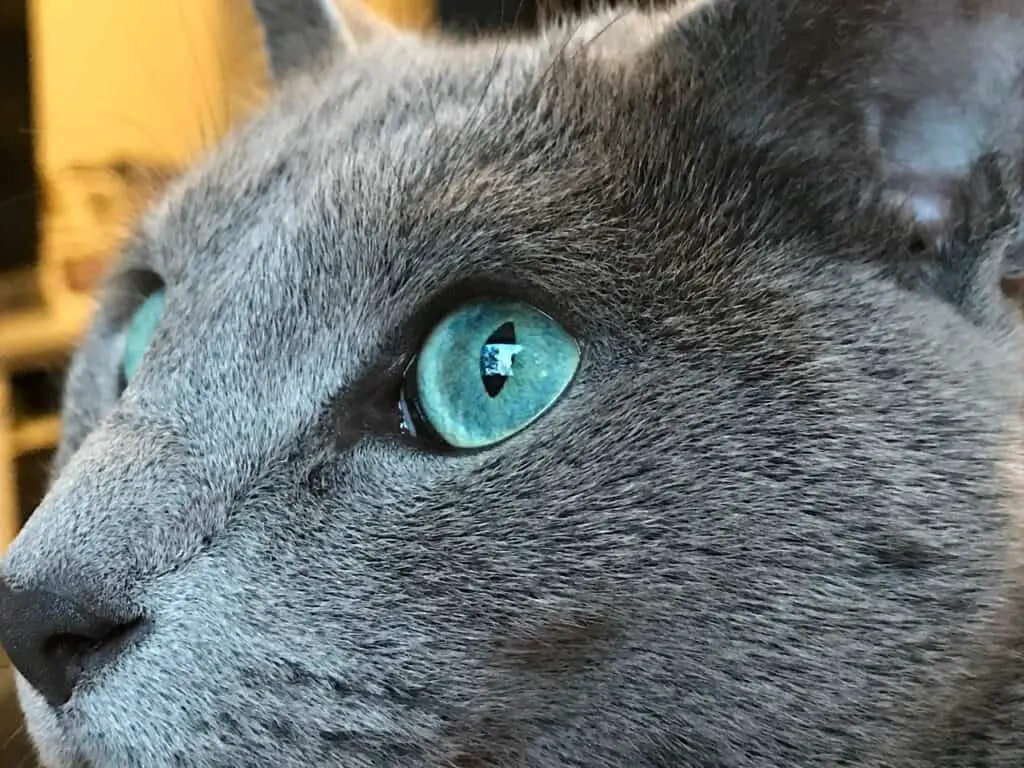
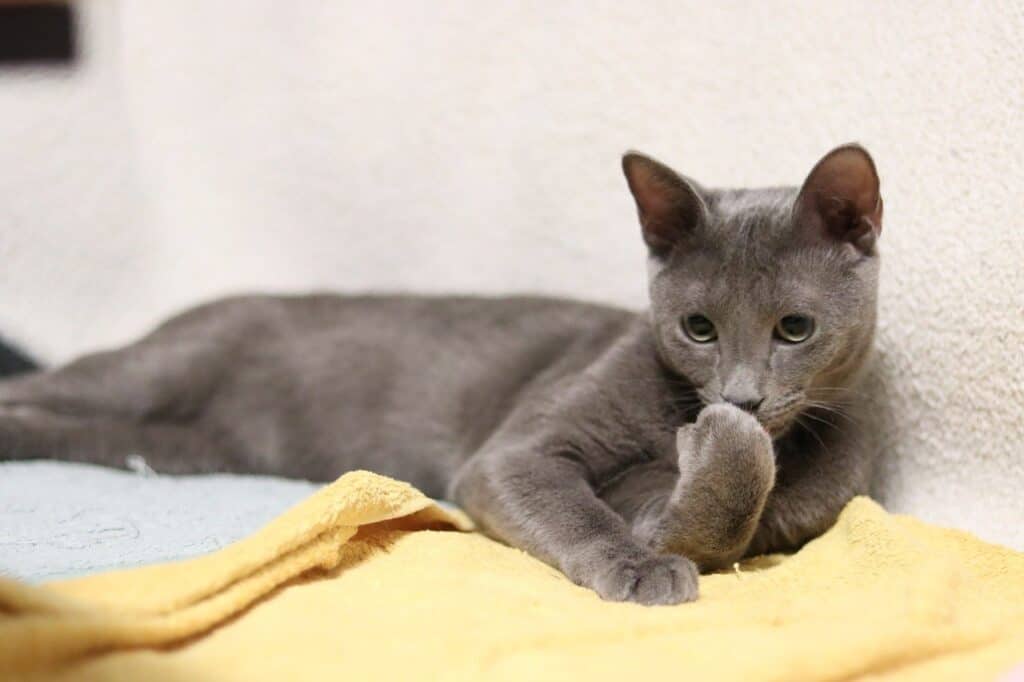
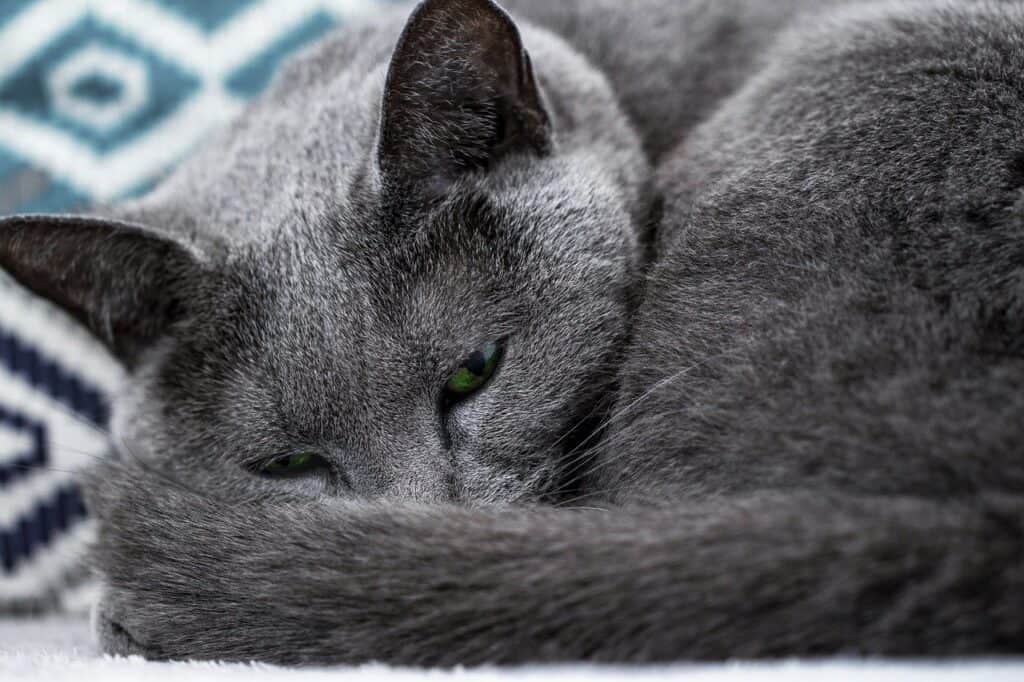
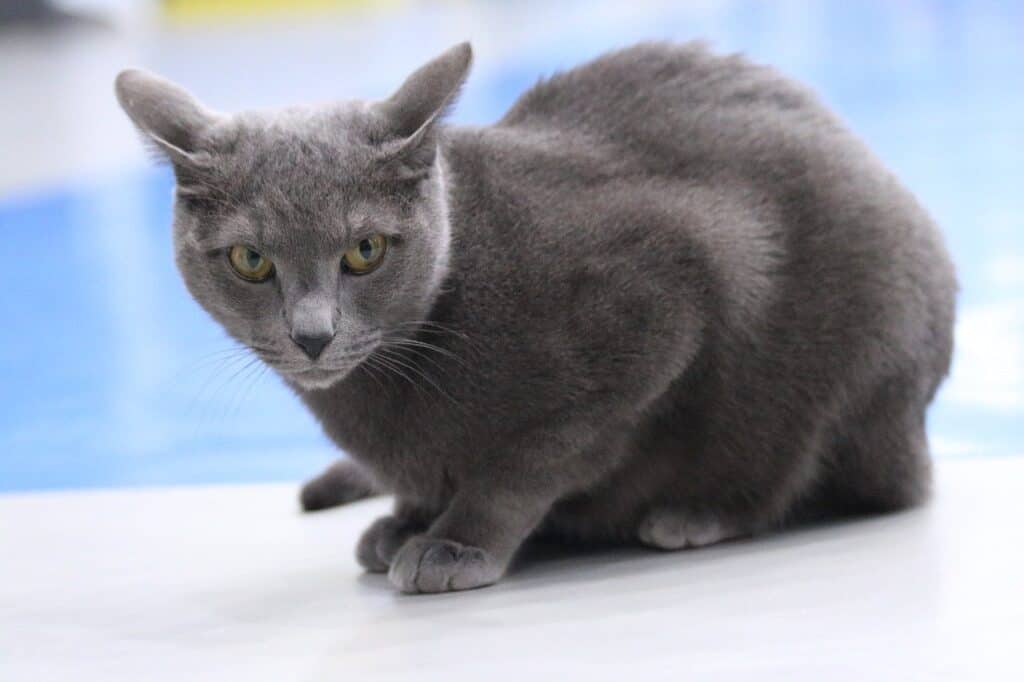
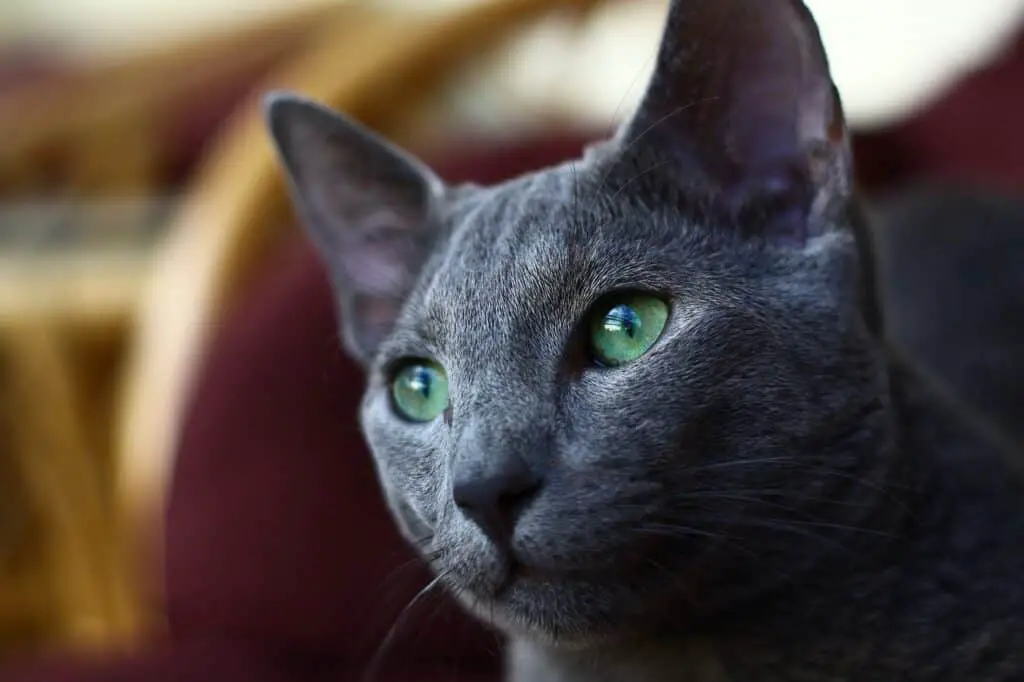
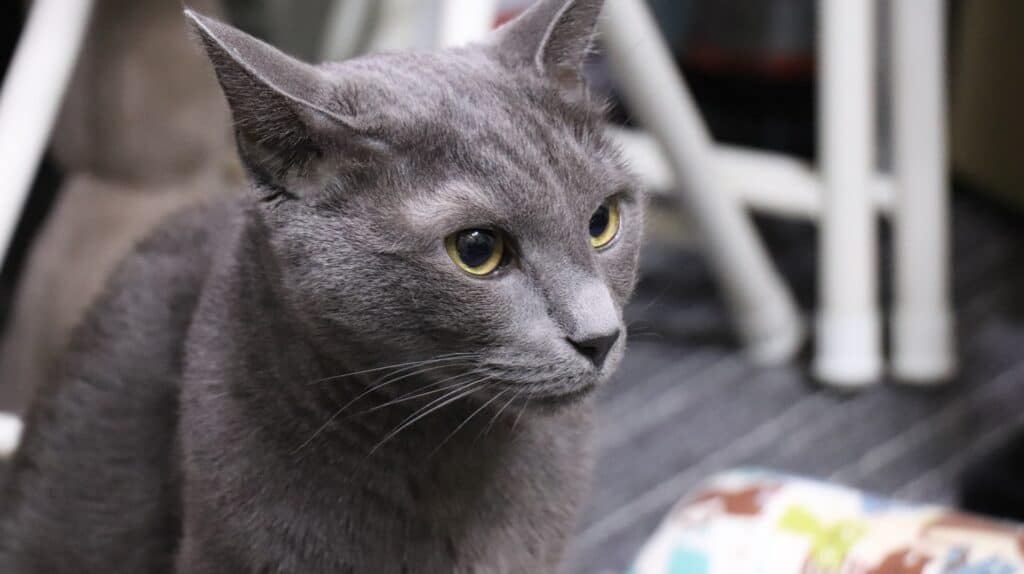
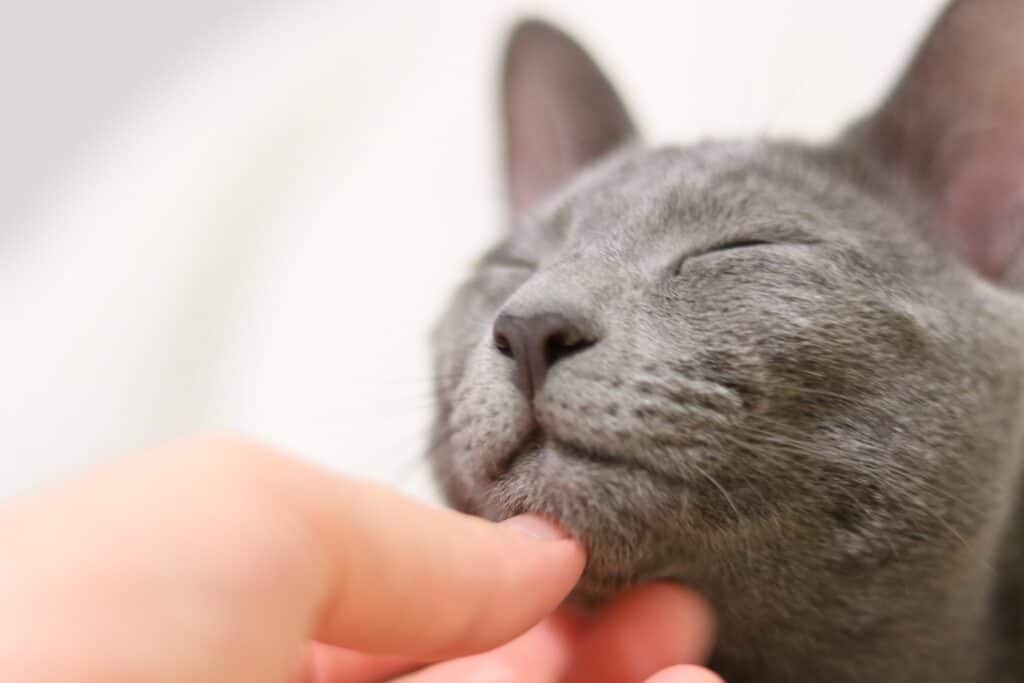
Blues have long legs and small rounded paws. They walk elegantly, and it almost looks like they are tiptoeing. Their tail is long, straight, and tapers towards the tip.
Also, it is worth noting that the Russian Blue has some particular features in different regions.
In Russia and Scandinavia, the breed is small and with ears far apart. In England, the Russian Blue’s body is more robust, and the ears are closer together and pointed upwards. Finally, in the United States, the ears remain further apart, and the animal’s size is slightly smaller.
Russian Blue personality traits
The Russian Blue is an independent, intelligent, and very clean cat. They can live happily in a small apartment, but not in a spacious and noisy house. They love a quiet environment without surprises since they prefer to follow their routines with complete peace of mind.
Intelligence
If you’re looking for a cat that will happily learn to perform tricks, a Russian Blue is perfect. They’re intelligent enough to learn how to perform certain actions by just looking at how you do it and then copying you.
Blues will easily learn everything you teach them and even things you’d rather not want them to copy. For example, if you prefer them not to open doors, cabinets, and windows, you should take your precautions because they will watch you do it until they can do it themselves.
With their well-developed intellect, you will hardly find a Russian Blue in trouble. They are usually cautious and tend to analyze the situation before proceeding.
Cleanliness
As mentioned, Russian Blue cats are very clean, and they expect the same from you and the home they live in.
Their daily hygiene routine involves frequent grooming, which sometimes may come across as excessive and compulsive. Even after eating the smallest snack, they need to clean themselves thoroughly.
Their litter box should always be spotless as well. Russian Blue cats refuse to use a dirty litter box. If it’s not to their liking, they will find another place to relieve themselves to let you know they expect you to do a better cleaning job.
Playfulness
Blues love to play games, which is why they get along well with children, as long as they are not provoked. For example, the Russian Blue that I owned several years ago loved to play hide and seek and wanted me to chase him throughout the house. He enjoyed racing and using the furniture as an obstacle course.
Adapting to strangers
Russian Blues are usually reserved with strangers and will try to hide from their presence. Although most cats are shy when it comes to strangers, this breed can be extreme. However, as long as they have a place to be by themselves, it’s not really an issue, and with more frequent visitors or people they have gotten to know, they are very calm and affectionate.
One thing to note is that, although not impossible, it’s hard to get them to accept other pets in your household, especially if your Blue is a bit older. Like with people, it will take them a long time to warm up to a new pet, if they even accept them at all.
Once they accept others (people and pets), they are friends for life, though.
This cat is a devoted companion once they decide you are worthy of its company. Russian Blue cats have a deep connection with their pet parents, and they will enter into a loving and caring relationship with you once they trust you.
Is a Russian blue good for families?
Russian Blue cats a real family pets. They adapt very well to family life. They crave attention and playtime. Children can provide the mental stimulation that Russian Blues need with regular play and petting. Russian Blues love the interaction and will thrive in families.
The Russian Blue cat tends to have powerful bonds with its family, particularly often with one of its members. In addition, their relaxed and even-tempered personalities make them very tolerant of children.
Russian Blue cats make an excellent companion for any family.
As with any cat, parents should explain to the little ones that they cannot bother the cat by grabbing its tail or engaging in activities that might be painful or scary to your cat.
Is Russian blue hypoallergenic?
Oh, and great news for those who are allergic to cats but always dreamed of having a pussy indoors: the Blue Russian is a hypoallergenic breed.
That is, these kitties do not cause allergic reactions like other cats. The reason for this is simple: the Russian Blue cat produces less glycoprotein Fel d 1 protein than other breeds, which is considered a major cause of allergies in people.
Nutrition of the Russian Blue: Dosage and frequency of meals.
To formulate a specific diet for the Russian Blue, it is essential to identify the ideal amount of food to be given to the cat and the most appropriate times of the day.
Generally, this breed is not particularly prone to over-eating, and, for this reason, they are not predisposed to accumulating excess weight. Especially when fed a balanced and healthy diet.
As a general rule, the ideal daily food intake for Russian Blues is around 150-200 grams of wet food and 50-70 grams of kibble. For more detail, the table below gives additional insight into how many calories they need.
| Daily recommended calorie intake for cats (in Kcalories) | 5 lbs | 10 lbs | 15 lbs | 20 lbs |
| Kitten | 200 | 400 | 600 | 800 |
| Lean Adult Cat | 170 | 280 | 360 | 440 |
| Overweight Adult Cat | 180 | 240 | 280 | 310 |
| Nursing Cat | 336 | 603 | 850 | 1090 |
In any case, it would be preferable to seek advice from the veterinarian to obtain quantities specially calculated based on a series of individual parameters, such as the age, lifestyle, and health conditions of the cat.
As for the frequency of meals, the ideal would be to feed the Russian Blue twice a day, once in the morning and once in the evening. Alternatively, it is possible to divide the daily rations into smaller portions to feed the cat during the day.
What to feed the Russian blue
- Most of their calorie intake should come from wet food containing meat (or the occasional fish) – Apart from that, it’s healthy and resembles their natural diet; wet food also helps keep your cat well hydrated.
- If you have the option, it would be great to prepare some fresh food (meat/fish) for your cat now and then.
- Spread the feeding sessions out over the day, ideally three times for breakfast, lunch, and dinner. – Cats have small stomachs and prefer to eat small amounts throughout the day.
- You can supplement their diet with some high-quality kibble – Limit this to 1 cup per day to avoid feeding too many carbohydrates, which they have trouble digesting. Feeding kibble has some advantages; for instance, keeping your cat’s teeth in good condition is great.
- Treat your cat with a healthy snack to keep her tummy full between meals.
Provide sufficient water
Like humans, cats are about 70% water which needs to be regularly replenished. Your cat needs to drink sufficiently, so make sure there is always a bowl of fresh water around.
Cats that eat a lot of wet food will drink less water because wet food typically contains about 75% water. Dry cat food/kibble only contains 10% of liquid, which is another reason to feed primarily wet food to your cat.
Minerals that your cat needs
Minerals are essential for cats. They are the building blocks of our bodies, and to keep your cat in top condition; she needs sufficient minerals to stay healthy.
Sadly, most (cheaper) supermarket food often lacks these important building blocks. Therefore, we always recommend going for the premium cat food brands such as Royal Canin, Hills, Purina, or others for a balanced diet.
The list below gives an overview of what minerals are important for your cat and should be present in a balanced diet. For more details and quantities, have a look at this great resource from the National Research Council.
- Chloride
- Potassium
- Sodium
- Calcium
- Magnesium
- Phosphorous
- Iron
- Copper
- Zinc
- Selenium
- Iodine
- Vitamins A, D, E, K, B1, B6, B12
- Riboflavin, Niacin, Folic Acid, Pantothenic Acid
Russian Blue’s health
Russian Blue cats generally tend to be strong and in good health. However, all purebred cats are more prone to a number of congenital diseases than mixed breeds. The diseases that most affect the Russian Blue cat are:
- Hypertrophic cardiomyopathy – This disease affects your cat’s heart muscle and may, over time, affect their overall health and activity level. It’s hard to diagnose but can be treated.
- Polydactyly – This is a genetically inherited trait that causes the cat to be born with more than the usual number of toes on one or more of its paws.
- Other genetic mutations that may or may not be apparent at birth are common in Russian Blues.
Also, note that the Russian Blue cat is more likely to contract infectious diseases or parasites, such as:
For your Russian Blue cat to always have excellent health, it is recommended to strictly follow the vaccination and internal and external deworming calendar, especially if he leaves the house.
Following this advice, the Russian Blue cat can live between 10 and 15 years. The oldest Russian Blue known to man lived to be 25 years, but this is really exceptional.
Recommended care for Russian Blue Cat
a. Brushing and grooming
Although Russian Blue has a double layer of fur, the truth is that the coat type of this animal does not require particular care.
It is recommended to provide minimal grooming and brush them at least once a week just to be on the safe side to help remove some dead hairs and keep their coat healthy. But since this is a hypoallergenic breed, the Russian Blue cat doesn’t usually give you much work in this regard.
On the other hand, Bathing is not something that has to be part of this cat’s care routine either. But whenever the animal is very dirty, it is worth investing in more effective cleaning with veterinary products.
b. Nails, teeth, and ears
Trimming cat nails is important for all breeds.
As many of you know, cats instinctively scratch furniture and other objects to sharpen their claws when they grow too long. So, don’t forget to cut your cat’s nails regularly.
In addition, keeping the cat’s oral hygiene up to date is also necessary to prevent dental issues at a later age. Therefore, we advise you to brush your Russian Blue’s teeth from time to time.
To avoid your Blue getting ear mites, clean their ears with a soft and damp cloth to avoid ear wax building up. It’s best not to mess around with cue tips at the risk of hurting your cat.
c. Food
Every animal needs to feed properly to grow strong and healthy, which is no different from the Russian Blue cat. However, age is the first point that must be evaluated when choosing the best feed for your four-legged friend, as each stage of life requires a specific amount of nutrients.
If there is any problem with the cat’s health, such as kidney problems, unary tract disease, or cat diabetes, your cat may need a special diet. In general, we always advise choosing reputable brands like Hills, Purina, or Royal Canin.
Consult your vet to find out what diet is best for your Russian Blue.
d. Hydration
Cats usually have a harder time drinking water daily, which usually makes them quite susceptible to kidney disease and other health problems.
Therefore, a good alternative to encourage the hydration of the Russian Blue cat is investing in water sources or spreading water fountains around the house.
In addition, opting for wet food instead of dry kibble can also be a good way to ensure that your cat is hydrated regularly and sufficiently.
e. Exercise
The Russian Blue cat needs physical stimulation to stay healthy. The best way to ensure that your pet will not sit still is to encourage animals to play and exercise.
You can do this by installing suspended shelves which the cat can exercise by jumping on it. Also, cat toys are a great way to do this, as every cat loves to relive their hunter habits.
Nothing beats playtime between you and your beloved Russian Blue. It will strengthen your bond, and your Blue will love you for spending time with her.
Russian Blue Cat: Pricing
If you want to have a kitten of this breed, there must be some financial planning. In addition to the monthly expenses that a feline requires, the Russian Blue cat tends to be more expensive than other breeds because of its rarity.
In general, prices range from $800 to $1200, but this will also depend on the animal’s lineage and age. In some cases, you might find them cheaper but be careful to only deal with a reputable breeder that treats their animals well and have the proper paperwork that comes with purebred cats.
Always look for a reliable cattery with good references so as not to fall into traps. If you can, make a few visits before purchasing to make sure all the animals are well cared for by the breeder.

